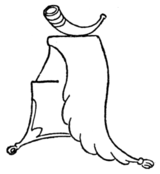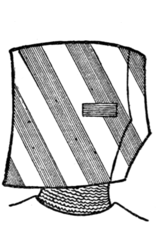de-fer," which is first mentioned in documents at this period, and was shaped like a flat-topped, cylindrical cap. This, however, was soon enlarged so as to cover the whole head (Fig. 564), an opening being left for the features, which were sometimes protected by a
 Fig. 567. |
 Fig. 568. |
 Fig. 569.—Painted "Pot-Helmet," c. 1241. |

Fig. 570.—"Pot-Helmet," from the Eneit of Heinrich von Veldeke.
movable "ventaille," or a visor, instead of the "nasal." This helmet (which was adopted by Richard I., who is also sometimes represented with a conical one) was the earliest form of the large war and tilting "heaume" (or helm), which was of great weight and strength, and often had only small openings or slits for the eyes (Figs. 565 and 566). These eyepieces were either one wide slit or two, one on either side. The former was, however, sometimes divided into two by an ornamental bar or buckle placed across. It was afterwards pointed at the top, and otherwise slightly varied in shape, but its general form appears to have been the same until the end of the fourteenth century (Figs. 567, 568). This type of helmet is usually known as the "pot-shaped." The helmets themselves were sometimes painted, and Fig. 569 represents an instance which is painted in green and white diagonal stripes. The illustration is from a parchment MS. of about 1241 now in the Town Library of Leipzic. Fig. 570 shows another German example of this type, being taken from the Eneit of Heinrich von Veldeke, a MS. now in the Royal Library in Berlin, belonging to the end of the twelfth century. The crest depicted in this case, a red lion, must be one of the earliest instances of a crest. These
